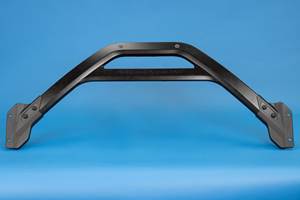Materials selection for automotive is a meritocracy
CompositesWorld's editor-in-chief Jeff Sloan caught up with CAMX 2015 keynote speaker Dr. Gary Smyth, executive director of Global Research and Development at General Motors (GM, Detroit, MI, US), for a pre-show interview and came away with some interesting comments about the role composites will play in automotive manufacturing.
October is CAMX month, and we here at CW are gearing up for the show, Oct. 26-29, at the Dallas Convention Center in Dallas, TX, US. We’ll have a booth there, and we’re publishing the CAMX Show Daily newspaper on site.
Preparatory to the show, I was given a chance to conduct a Q&A with this year’s CAMX keynote speaker, Dr. Gary Smyth, executive director of Global Research and Development at General Motors (GM, Detroit, MI, US). Doing a Q&A with a high-level corporate executive can be an uncertain proposition; some in this position hew so closely to the company line that getting meaningful and interesting answers can be a challenge. However, it’s just as likely that a Q&A will elicit illuminating and informative feedback that actually carries weight. Dr. Smyth, I’m happy to report, falls into the latter category.
I don’t have room here to record all he said. You can find the entire Q&A here. What I can do is share with you some comments he made that elucidated the role composites will play in automotive manufacturing.
First, if you are a regular reader of this column, you know that I have expressed concern that the composites industry, in general, is not well suited to meet the rigorous demands of the automotive supply chain, and I have questioned where composites fabricators will fit in the tier channel should automakers decide to more seriously work composites into cars and trucks.
So, my question on this topic for Dr. Smyth was: The composites industry does not have a history of providing high-volume, just-in-time (JIT) manufacturing services. If GM increases composites use, how will it cope with this challenge?
Dr. Smyth’s reply: “This is a significant issue and compounded by the complexity of the composites value chain. In the metal world, we buy sheet metal and stamp it into a part or, in some cases, buy a pre-made assembly. In the composites world, there can be a resin supplier, a fiber supplier, a molder, and then a component assembler or finisher/painter. This makes it very difficult to manage the whole value chain. One approach would be to bring the technology in-house; another is to closely partner in the plant, much as we do for the paint shop today. What is clear is that to enable true high-volume implementation, the right decisions need to be made early in part and process design to optimize material use and minimize manufacturing issues.”
I added the italics in Dr. Smyth’s answer because I think that sentence captures very nicely some of the concerns automakers have when they look at the composites industry: Complexity, uncertainty, multiple materials. And given this uncertainty, it’s fair then to ask: What advice do you have for composites fabricators who seek greater involvement in the automotive supply chain?
Dr. Smyth’s reply: “.... I would suggest working with Global Purchasing and Supply Chain to introduce your capability and then become part of the bidding process on future components. You should also reach out to technical leaders so they are aware of your capability. One key to getting GM’s attention is to clearly communicate the value or uniqueness that you bring as a supplier and to quantify that value. This often is done through a well-described case study for components you have produced for other industries or OEMs where you demonstrated improved performance or lower cost or better global reach.”
Again, I added the italics, which get at the crux of the issue for composites, which is that they must earn their way onto cars. The automaking business model is simple: Make high-quality, safe vehicles for as little money as possible. Materials selection is, in the end, a meritocracy, and composites fabricators must prove the value their products have.
This is easier said than done, but if it were easy, everyone would be doing it. However, it is doable. To get started, I encourage you to show up at CAMX, hear what Dr. Smyth has to say, and put to him a few questions of your own.
Related Content
McLaren celebrates 10 years of the McLaren P1 hybrid hypercar
Lightweight carbon fiber construction, Formula 1-inspired aerodynamics and high-performance hybrid powertrain technologies hallmark this hybrid vehicle, serve as a springboard for new race cars.
Read MoreInfinite Composites: Type V tanks for space, hydrogen, automotive and more
After a decade of proving its linerless, weight-saving composite tanks with NASA and more than 30 aerospace companies, this CryoSphere pioneer is scaling for growth in commercial space and sustainable transportation on Earth.
Read MoreAutomotive chassis components lighten up with composites
Composite and hybrid components reduce mass, increase functionality on electric and conventional passenger vehicles.
Read MoreSMC composites progress BinC solar electric vehicles
In an interview with one of Aptera’s co-founders, CW sheds light on the inspiration behind the crowd-funded solar electric vehicle, its body in carbon (BinC) and how composite materials are playing a role in its design.
Read MoreRead Next
Developing bonded composite repair for ships, offshore units
Bureau Veritas and industry partners issue guidelines and pave the way for certification via StrengthBond Offshore project.
Read MoreAll-recycled, needle-punched nonwoven CFRP slashes carbon footprint of Formula 2 seat
Dallara and Tenowo collaborate to produce a race-ready Formula 2 seat using recycled carbon fiber, reducing CO2 emissions by 97.5% compared to virgin materials.
Read MoreVIDEO: High-volume processing for fiberglass components
Cannon Ergos, a company specializing in high-ton presses and equipment for composites fabrication and plastics processing, displayed automotive and industrial components at CAMX 2024.
Read More












.jpg;maxWidth=300;quality=90)









